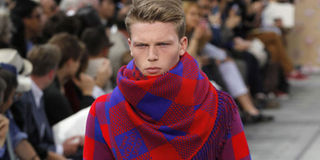Global fashion pays homage to ‘shuka’

AFP PHOTO/FRANCOIS GUILLOT
A model presents a Louis Vuitton design during his spring-summer 2012 men's fashion collection show, on June 23, 2011 in Paris.
Last week, something profound happened in international fashion.
I say profound because it woke Kenyans up to the impact the country has the potential to make.
Louis Vuitton’s cutting-edge imagination saw Maasais leap all the way across oceans and seas to the fashion house’s drawing board and translated onto their runways.
To the rest of the world, Kenya is Maasailand. Nearly every tourist who comes in wants a cultural token from them to take back home as proof of visit.
Women who make manyattas, beaded jewellery, elaborate neckpieces and bracelets, and who tie sunny red, orange and yellow shukas around their frames and don colourful beads on their elongated lobes are legendary.
Likewise men who hunt lions to prove their worth as warriors. In fact, nobody sells Kenya like the Maasai do.
Which is why it is surprising that anyone is shocked Louis Vuitton incorporated the shuka in its spring/summer collection of 2012.
The ludicrous part of the show lies in the inspiration behind it. Apparently Kim Jones, head of menswear, under the artistic direction of the famously talented and equally attractive Marc Jacobs was inspired by images shot by Peter Beard.
Beard is the man the fashion world seems to credit rather generously for his model discoveries, mainly Iman.
His images of Africa, African landscapes and vast savannah studded with wildlife turned him into a David Livingstone of sorts in the fashion capital of New York.
Jones said of the shuka creations: “(Beard) is a hero of mine. This is a nod to him and a fictionalised imaging of that period of travel to Africa in the sixties and seventies.”
And in that sentence, he also summed up the fact that modern fashion is now heavily leaning towards the 60s and 70s. The shirts, shorts and keffiyehs that pay tribute to cowboys were a merger or red and blue and could be worn with khakis.
They have a summer tourist feel to them and were largely worn with sandals. With images dating back almost 40 years, it was this retro touch that Louis Vuitton pegged its men’s collection on.
Reaction
What is even more ironic about the house’s fashion collection is the reaction it received. The Maasai shuka is both famous and infamous.
It defines a culture, people and history, which can be a double-edged sword because while internationally it will receive acclaim, locally it will be one of those things that we feel is overly commercialised.
Further, about 20 years ago, fashion veteran and designer Sally Karago, now heading McCensal Ltd, exhibited a collection made out of the Maasai blanket. It picked up steam locally and proved to be quite a hit.
And last year during the African Fashion Fair, Lucy Rao’s collection was inspired by the Maasai shuka and had distinct shades of red and burnt orange. Louis Vuitton is not the first to embrace our local fabrics; they are simply prolific enough to seem like pioneers.
What their collection proves, also, is that Africa is the new, hip, fecund ground where seeds of creativity are drawn from. It is steadily becoming the motherland of fashion.
There is a famed expression about fashion. That if you see something in fashion (mainly in the US Vogue) give it another 20 years and it will experience a revival.
Well, we have come full circle. Fashion is retro and Africa is the hotspot. Our print fabric attracted the likes of Gwen Stefani’s spring/summer L.A.M.B collection early this year. Yet even with this wealth and ingenuity, we still lag behind when it comes to our own individual fashion sense.
Our support for the industry is occasional and seasonal, limited to cocktail outfits, weddings and the odd beauty pageant queen who gets crowned and travels abroad to represent us in something custom made by a Kenyan fashion house.
We treat fashion like an insignificant child then get surprised when someone else has the foresight to parent – and patent it.
Does anyone remember the kiondos? Or the acacia tree? We will revel in telling our children how they once belonged to us. That they are or were indigenous to Kenya and yet we never owned any of it.
Piece of fabric
And that’s not all. There is the leso. The fabric that knots a baby to a woman’s back when she is farming, leaving plum feet and a helplessly swaddled little tot with its surprised or wailing head sticking out.
That piece of fabric will now forever be aligned to Lalesso, a South African fashion house based in Cape Town.
It started simply enough. Olivia Kennaway and Alice Heusser came to holiday in Lamu. They saw an opportunity to market the vibrant fabric, and with it, created jobs for Kenyan locals.
They used maasai beadwork and coconut buttons all made in Kenya to tag their creations for their spring/summer 2011 collection.
Their workshop, SOKO, sells stuff made by Kenyans internationally. Their work has been showcased in Cosmopolitan, Glamour, Arise Africa, Cleo, Elle and a host of other South African publications.
How is it that it took only a holiday for them to crack the whip on local fashion so loudly. Yet we spread our lesos on the ground at Blankets and Wine, use them to absorb baby spit and wrap it recklessly around ourselves, not recognising the fashion potential it carries.
This month, take a fresh look at Kenyan fashion and ask yourself why your wardrobe is not bursting with more of it.




